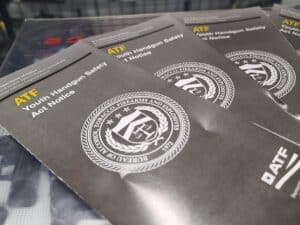The current director of the ATF is too favorable towards the gun industry.
At least, that’s what The New York Times seems to think. In a recent story by reporter Glenn Thrush, acting director Marvin Richardson is painted as at odds with President Joe Biden’s agenda. Thrush described him as “an industry-friendly subordinate pumping the brakes” on the President’s aggressive gun-control message.
So, what makes Richardson so friendly towards the industry he regulates? Well, he went to the industry’s trade show. And he announced new rules restricting guns with pistol braces and expanding the ATF’s power to determine what constitutes a firearm would be finalized by this summer.
These are odd complaints.
For one, the ATF has been attending the industry trade show for decades. The National Shooting Sports Foundation (NSSF), the industry’s trade group, gives them and several other federal agencies booths on the convention floor. Officials often speak at informational events as well.
As I’ve witnessed firsthand at numerous shows, this point is to help gun dealers stay in compliance with federal law. The ATF fields questions from the businesses they regulate and passes on updates about potential coming changes to regulations. Thrush dings Richardson for the second part of that function in particular.
He claims Richardson is slow-walking President Biden’s rule expanding the ATF’s power to determine what a firearm is under federal law. During his event at the trade show, Richardson said the regulation, which the President hopes to use to target “ghost guns,” is due to be finalized by June. Thrush claims it was “expected to have already been in place.”
But that doesn’t match the timeline previous rulemaking on firearms has gone through. The bump stock ban took over a year to be implemented through federal rulemaking. The “ghost gun” rule change is on pace for a similar timeline despite the overwhelmingly negative public comments it received. Thrush presents the fact that the rule hasn’t already been finalized and implemented as some sort of win for the gun industry.
This, too, is odd.
The gun industry gains basically nothing from having the “ghost gun” or pistol brace rules delayed a couple of months. They don’t want them implemented at all. That’s why they helped organize the commenting campaign.
The politics are pretty far off from reality.
The piece goes sideways on the basics of guns and gun law as well. The way it describes gun policies borders on gibberish. The utter lack of understanding by everyone involved in the piece for how guns and gun laws work is on full display.
It talks about the fight over “restrictions on military-style firearms.” Of course, “military-style firearms” is a vague term that I’m guessing is meant to apply to AR-15s or AK-47s, but which could easily apply to nearly any gun that’s ever been employed in some way by a military. Since militaries have used pretty much every kind of gun (from fully-automatic to semi-automatic to bolt-action and pump-action) ever invented, it could apply to almost literally anything.
The piece then asserts “red flag laws” are meant to “keep mentally ill people from carrying guns.” But that isn’t what red flag laws do. Instead of keeping those subject to red flag orders from carrying guns, it temporarily confiscates their firearms altogether.
It also talks about proposals for “enhancing background checks.” But the universal background check proposals, which have been at the center of the gun debate for literally decades, are not about “enhancing” background checks. Instead, they are focused on expanding checks to used gun sales on the private market or, as is the case with the proposal the House passed last year, to any time somebody transfers a gun to somebody else with few exceptions.
But that’s just what was left in the piece. The Times actually edited out the worst bit without a correction. It described Biden’s proposed rule to effectively ban and register guns equipped with pistol braces as “a rule banning the use of high-capacity ‘bump stocks.'”
Pistol braces aren’t bump stocks. They aren’t stocks at all. They’re designed to be strapped around a shooter’s forearm to stabilize it while shooting. They’re used to keep guns with barrels shorter than 16 inches from being considered “short-barreled” rifles or shotguns since whether the gun was designed to be pressed against the should while firing (as a stock implies) plays a big role in that determination.
And, of course, bump stocks are… stocks. They aren’t ammunition magazines. They don’t have a “capacity.”
That is an embarrassing word salad of buzzy gun terms. It is pretty amazing The Times didn’t even attempt to fix the description of the rule and instead stealth edited it away. It seems they figured out it was wrong but couldn’t figure out an accurate way to describe it.
There are also several reasons to think President Biden’s failed ATF Director nominee David Chipman was relied on for much of the narrative in the piece. Chipman’s first interview after bowing out of consideration was with Thrush, who treated him with a very light touch in stark contrast to how he’s treating Richardson. In this piece, as in the interview, Thrush pins Chipman’s downfall on the spread of a picture falsely said to have been of him standing in front of burned buildings after the shootout at Waco.
Thrush doesn’t mention that Chipman was, and still is, a paid gun-control activist with a history of making controversial remarks that denigrate gun owners. Nor does he mention the outcry by current and former ATF agents against Chipman’s nomination–including a black agent who accused Chipman of torpedoing his career due to racial animus (Chipman has confirmed the incident but denies wrongdoing).
Thrush also makes a point to note that Richardson, who is African-American, was at Waco. He claims this presents a contrast to Chipman. This, too, is odd because, while he wasn’t in the picture erroneously shared by NSSF and others, Chipman was also at Waco in the aftermath of the shootout.
Perhaps Thrush was taken in by his sourcing. But it’s one thing to report what competing groups are saying; it’s another entirely to do it uncritically. Of course, looking at what you’re being told with a skeptical eye requires a level of knowledge on the subject that it’s fairly clear Thrush and his editors don’t currently possess.
They aren’t alone either. This is just one piece, but it’s emblematic of a larger issue.
Major media has serious problems with firearms reporting that extend well beyond just a lack of knowledge on the details, or even basics, of how guns and gun laws work. Despite the access and sourcing commonly available to them, most outlets can’t get the politics at play right either.
It’s no wonder gun owners have so little faith in mainstream outlets.
UPDATE 3-13-2022 11:20 AM EASTERN: This piece has been updated to include an explanation of pistol braces.






2 Responses
What’s the solution to media ignorance? Trying to get them to the range and learn more about firearms? Or, send them corrections in a mass effort? Or expose their ridiculousness as you have done here across a wider media distribution?
I think all three of those are important parts of the solution. On a personal level, trying to correct mistakes in a hospitable way is likely to be the best approach. Being a knowledgeable resource can make a real difference.